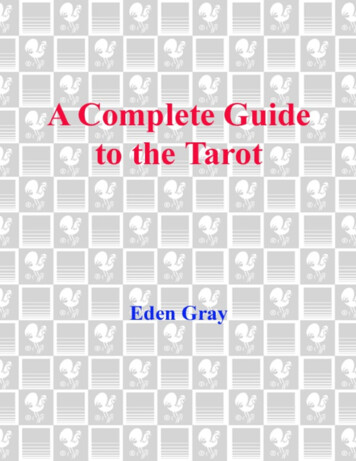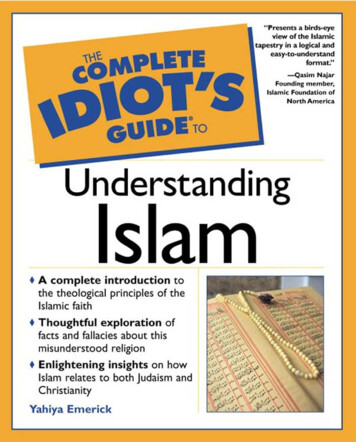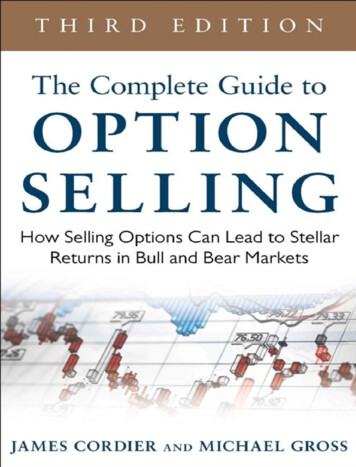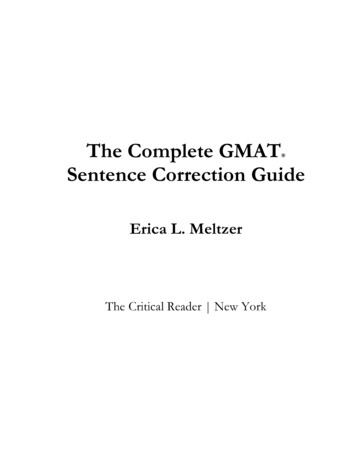
Transcription
THE MYSTERY OF THE TAROTThe origins of the Tarot are so veiled in the mists of time that it is only natural for myths andlegends to surround it. Superstition, flights of fancy, and speculation have added their ownpatterns to the rich and colorful tapestry of Tarot lore and have only deepened its aura of magicand mystery. Cults have grown up around one or another historical theory, and sometimes theiradherents have become fanatical in proclaiming the one and only “truth.” But the betterinformed investigators retain a certain amount of flexibility—even skepticism—and make noironclad assertions.The truest claim we can make is that the Tarot is a symbolic record of human experience.Through deeply rooted mystic powers, the cards accomplish miracles of psychological insight,wise counsel and accurate divination.
Other Bantam Books of related interestAsk your bookseller for the books you have missedTHE COMPLETE BOOK OF PALMISTRYby Joyce WilsonSOULMATES by Jess Stearn
A COM PLETE GUIDE TO THE TAROTA Bantam Book / published by arrangementwith Crown Publishers, Inc.PUBLISHING HISTORYCrown edition published June 1970Universe Book Club January 1971 SelectionBantam edition / June 1972All rights reserved.Copyright 1970 by Eden GrayNo part of this book may be reproduced or transmitted in any form or by any means, electronic or mechanical, including photocopying, recording, or by anyinformation storage and retrieval system, without permission in writing from the publisher.For information address: Crown Publishers, Inc.201 East 50th St., New York, N.Y. 10022.eISBN: 978-0-307-77944-1Bantam Books are published by Bantam Books, a division of Random House, Inc. Its trademark, consisting of the words “Bantam Books” and the portrayal of arooster, is Registered in U.S. Patent and Trademark Office and in other countries. Marca Registrada. Random House, Inc., New York, New York.v3.1
CONTENTSCoverOther Books by This AuthorTitle PageCopyrightAcknowledgments1THE TAROT DEFINED2HISTORY OF THE TAROT3THE M AJOR ARCANA4THE M INOR ARCANAWandsCupsSwordsPentacles5HOW TO READ THE CARDS6THE TAROT AND M EDITATION7SYSTEM S OF OCCULT THOUGHT THAT ILLUM INATE THE TAROTThe Tarot and NumerologyThe Tarot and the KabalahThe Tarot and Astrology8EPILOGUE—THE FOOL’S JOURNEYGlossary of Symbolic TermsBibliographyAbout the Author
ACKNOWLEDGMENTSMy deep appreciation to Nan Braymer for her invaluable assistance in the preparation of themanuscript of this book.Also to Mary Beckwith Cohen for her advice on all matters that concerned Astrology.
1THE TAROT DEFINEDThe ancient and mystic pack of cards called the Tarot never fails to evoke the curiosity of theuninitiated. “What are the Tarot cards?” “What makes them so different from our own playing cards?”“Can they really foretell the future?” “Can anyone learn how to read them?”This book is devoted to answering these and many other questions and to give the reader aknowledge of the Tarot—its history, its links to other occult sciences, and the way it is used to shedlight upon the past, the present, and the future.Everyone agrees that modern playing cards are directly descended from one part of the Tarot—theresemblances between parent and child are too striking to be accidental. In both we find cardsnumbered one to ten, followed by pictures or “court” cards. And just as the Joker is unnumbered andhas no assigned place in our deck, the Fool in the Tarot is also without a number of its own or apreordained position—yet both are ever present in their respective packs.There are 78 cards in the Tarot, of which 56 (those most like modern cards) are equally dividedamong four suits—Wands, Cups, Swords, Pentacles—analogous to our Clubs, Hearts, Spades, andDiamonds. These suit cards are known as the Minor Arcana (arcana is the Latin word for secrets).They are followed by 22 cards called the Major Arcana—cards that depict symbolic figures,elements in nature, the experiences of Man in his spiritual journey, his hopes and fears, his joys andsorrows.The Major Arcana, as can be seen, bear little resemblance to modern cards. Their illustrations aredrawn from the treasurehouse of universal symbols and images, from the legends, myths,philosophies, religions, and magic beliefs of the human race. Undoubtedly the wise men and seersthrough whom the Tarot is believed to have been transmitted over more than seven centuries werethoroughly versed in the astrological, numerological, and Kabalistic teachings of the ancients, and allthese influences are reflected in the cards. The Tarot, nevertheless, remains a unique and independentdiscipline with its own divinatory powers and its own spiritual content.Most of us are interested in character analysis, glimpses of the future, solutions to immediatedilemmas—all of which we can seek in the Tarot. But there are also those who will value the Tarot’shelp in meditation. The student of metaphysics gains remarkable insights into the inner meanings ofthe cards; the artist, constantly concerned with images and symbols, draws heightened creativity fromcontemplating the many-dimensional beauty of the cards; the Biblical student finds that the Tarotilluminates many passages in the Old and New Testaments. And since the Tarot is the key that unlocksthe wisdom of the ancient philosophers, it reveals its most profound messages to the dedicatedscholar and practitioner. (In this it is not unlike the ideographic writing of the Chinese, thehieroglyphics of the Egyptians, the picture writing of the Mayans.)It is not necessary, however, to understand all the hidden secrets of the cards at first—or evensecond—glance. When the student is ready, the Tarot will begin to reveal its mysteries. And it is notimperative to “believe in the cards” for them to yield results—you don’t have to take them on blindfaith. Eventually you will tap the occult powers of the Tarot, and you will turn to it when dilemmasbeset you.
If you consult an experienced “Reader” for help, you become what is called the “Querent,” with anunspoken question you want answered. After laying out the cards in accordance with one of themethods described in this book, the Reader will interpret what the cards are trying to tell you. But youyourself can learn the definitions of the symbols as given in the Glossary, as well as from the detaileddescriptions and pictures of each of the cards in the body of the book. Then, after mastering one oranother of the techniques for laying the cards out, you can before long try to read them. At first, ofcourse, you will be turning back to the definitions again and again, but with persistence you will berewarded.The first Tarot cards were painted on parchment or thin sheets of ivory, silver, or even gold. Thedesign for each card had to be drawn anew and colored by hand. Therefore the cards became theplaythings of the nobles, who could afford to assign an artist to paint their own individual sets. Oftenthe aristocracy had the Court cards drawn to resemble members of their own family or court.Eventually, handmade cardboard became available, and then the designs were traced and paintedwith watercolors. Later still, in Nuremberg (about 1430), block printing was done from hand-carvedwooden blocks. Thus some of the early cards are crude in design, and their details are oftenindistinct.To reduce the cost of a Tarot deck, or perhaps because the Major Arcana were not used in thegame of Tarroc, these 21 cards were dropped from the pack, as were the four Queens. At a later date,the Queens were evidently restored to some decks, and the Knights eliminated. Decks in this latterform are to this day used in the Spanish and Italian game of Tarroc. The cards from southern Germanydeveloped a somewhat different pattern—bells for Pentacles, acorns for Swords, leaves for Wands,and hearts for Cups.The cards depicted in this book are only one set of the many that have appeared during the longhistory of the Tarot. They are those used by A. E. Waite in his book The Pictorial Key to the Tarot(1910), and they have become standard for most of the English-speaking world. First published byWilliam Rider & Son, Ltd., they are called the Rider Pack.When people ask you, “What is the Tarot?” you should know a good part of the answer after youhave read the text and studied the strange and beautiful pictures. Those who are embarking on thisquest for wisdom and guidance will find it an exciting and rewarding journey with the help of theTarot—our priceless heritage from the ancients.
2HISTORY OF THE TAROTThe true Tarot is symbolism: it speaks a language that arises from the collective mind of Man. Givenan understanding of the inner meaning of the symbols, the cards yield, on the highest plane, mysticpowers and esoteric wisdom. And although there are various theories about the Tarot and manydifferent versions of the cards, no one of them can claim final truth and any one of them maycontribute some illumination.As an analogy, consider the hundreds of paintings and statues of Venus that have been made throughthe centuries. The goddess appears in numerous varied guises, according to the artist’s ownconceptions and the time in which he lived. Yet the representations retain recognizablecharacteristics, even though not only ideas but also styles and methods of drawing, painting, andsculpting are constantly changing.So it has been with the Tarot. Occultists, historians, and artists have modified details as newresearches present new evidence, but the best of these changes retain the basic symbolism.The origins of the Tarot are so veiled in the mists of time that it is only natural for myths andlegends to have grown up—particularly around the Major Arcana. Superstition, flights of fancy, andspeculation have added their own patterns to the rich and colorful tapestry of Tarot lore and,curiously enough, have only deepened its aura of magic and mystery. Cults have grown up around oneor another historical theory, and sometimes their adherents have become fanatical in proclaiming theone and only “truth.” But the better-informed investigators retain a certain amount of flexibility—evenskepticism—and make no ironclad assertions.The Gypsies say that the hidden knowledge of the Tarot was originally brought by their peoplefrom Chaldea and Egypt into Israel and thence to Greece. “Papus” (Dr. Gerard Encausse), a leadingFrench occultist, is quoted as saying: “The Gypsy has given us the key which enables us to explainall the symbolism of the ages. In it, where a man of the people sees only the key to an obscuretradition, [are] discovered the mysterious links which unite God, the Universe and Man.”It seems incontrovertible that there is some link between the Tarot and the Gypsies in theirworldwide wanderings. The Gypsies did indeed roam through Europe at about the same time that theTarot cards began to be used around the shores of the Mediterranean. They are heard of in Austria inthe twelfth century and in Rumania in the fourteenth. (It is interesting to note that the HungarianGypsy’s word for a pack of cards is “tar.”)Legend has it that as pagan cults became the victims of Christian persecution, the Hierophants(priests of the Eleusinian Mysteries) handed down their ancestral lore to the Gypsies, who undertookto transmit it only to those deemed worthy. For who would suspect that a wandering Gypsy was thecustodian of so precious a treasure? It is said that the Gypsy was also entrusted with the secrets of theGnostics, the Montanists, and the Manichaeans, as well as the Albigenses. These last were one of thesects of the Cathari, whose headquarters were the town of Albi. They flourished in the twelfth centurybut were exterminated in the thirteenth by the Crusades and the Inquisition. The Albigenses acceptedthe belief in dualism, renouncing marriage and eating no animal food. The Gypsies claim they alsoguarded the mysteries that were later embodied in the Jewish Kabalah, as well as those of the
Masonic Order.One of the most fascinating stories claiming that the Tarot originated in Egypt relates that after thegreat library at Alexandria was destroyed, the city of Fez (in what is now Morocco) became theintellectual capital of the world, to which wise men traveled from near and far. Needing to create acommon tongue—for they spoke in many languages—they set about inventing a method ofcommunication. To this end, they prepared a picture book abounding in mystic symbols. A key to themeanings of these signs was handed down by word of mouth from initiate to initiate. To preserve thesecrecy of their messages, the symbols were later reproduced on seemingly innocuous cards that wereused in games of chance by more frivolous men who could not possibly decipher their truesignificance.Another hypothesis attributes the invention of the Tarot to Thoth, counselor to Osiris. He was thescribe of the Egyptian gods, measurer of time, inventor of numbers, and the god of wisdom and magic,who is often depicted as having the head of the ibis. It has also been reported that interpretations ofthe 22 cards of the Major Arcana at one time formed part of the initiation ceremonies for the Egyptianpriesthood. One thing is certain: many of the Tarot symbols are clearly derived from Egyptianmythology.A study of the cards also discloses a close relationship to the Kabalistic lore of the ancientHebrews. In short, there can be no doubt that whoever actually invented the Tarot knew ancientreligions and philosophies and embodied many of their symbols in the cards. However, their deeperimplications may have been lost or deliberately hidden during the time when the Gypsies of southernFrance, Spain, and Italy used them as their stock-in-trade in telling fortunes.Granting these influences (as well as those of the Hebrew alphabet, color symbolism, Numerology,and Astrology), the truest claim we can make is that the Tarot is a symbolic record of humanexperience. Through deeply rooted mystic powers, the cards accomplish
design for each card had to be drawn anew and colored by hand. Therefore the cards became the playthings of the nobles, who could afford to assign an artist to paint their own individual sets. Often the aristocracy had the Court cards drawn to resemble members of their own family or court. Eventually, handmade cardboard became available, and then the designs were traced and painted with .











